AUCTORES
Globalize your Research
Research Article | DOI: https://doi.org/10.31579/2766-2314/123
1 Department of Medical Laboratory, Faculty of Medical Technology, Zawia University, Libya.
2 Department of Biochemistry, Faculty of Medicine, Sabratha University, Libya.
3 Department of Physiology, Faculty of Medicine, Sabratha University, Libya.
*Corresponding Author: Abdalrauf M.A.B. Department of Anesthesia, Faculty of Medical Technology, Surman, Sabratha University, Libya.
Citation: Abdalrauf M.A.B. Alfourti, Abdu-Alhameed A. Ali Azzwali, Azab Elsayed Azab, (2023), The Correlation between Hemoglobin-A1C and C-Reactive Protein in Type-II Diabetic Patients., J, Biotechnology and Bioprocessing, 4(7); DOI:10.31579/2766-2314/123
Copyright: © 2023, Abdalrauf M.A.B. This is an open access article distributed under the Creative Commons Attribution License, which permits unrestricted use, distribution, and reproduction in any medium, provided the original work is properly cited.
Received: 01 December 2023 | Accepted: 11 December 2023 | Published: 22 December 2023
Keywords: type 2 diabetes mellitus, correlation, hemoglobin-a1c, hba1c, c-reactive protein, crp
Background: Diabetes mellitus (DM) is a chronic metabolic disorder characterized by persistent hyperglycemia. It may be due to impaired insulin secretion or resistance to peripheral actions of insulin, or both. Poor glycemic control is significantly associated with the development of macro vascular complications. Earlier studies have indicated that C-reactive protein (CRP) is an important risk factor for cardiovascular disease as evident from its higher levels in people with diabetes mellitus compared to those without. Elevations in CRP are associated with an increased risk of insulin resistance by inhibiting skeletal muscle glucose delivery.
Objectives: The purpose of this study is to determine the relation between HbA1C and CRP in individuals with type 2 diabetes mellitus.
Methodolgy: A total of 140 patients were enrolled in the present study. They were divided into two groups according to if they are diabetic or non-diabetic as follows; 70 non-diabetics as the control group and 70 diabetics. Five milliliter of blood was withdrawn from venous blood by sterile syringes. The blood was collected in EDTA tubes to measure the HbA1c concentration and in clot tubes for biochemical assay (serum glucose and CRP concentrations).
Results: The result showed that the concentration of CRP and HbA1C among diabetic group was significant higher (Pless than0.001) when compared with non-diabetic group. In this study of 70 patients, the diabetic patients were divided into three groups according to the difference in HbA1C levels. Patients with HbA1C between of (5.0-7.0), HbA1C between of (8.0-10), and HbA1C of patients above 10. The results showed that there was a significant correlation between CRP and HbA1C (Pless than0.05) among the three groups.
Conclusion: In this study, a positive correlation between CRP and HbA1C was found. The finding regarding gender and age in this study suggested that CRP and HbA1C were not significantly associated with gender and age.
Diabetes mellitus (DM) is a chronic metabolic disorder characterized by persistent hyperglycemia. It may be due to impaired insulin secretion or resistance to peripheral actions of insulin, or both. According to the international diabetes federation (IDF), approximately 415 million adults between the ages of 20 to 79 years had diabetes mellitus in 2015 [1]. DM is proving to be a global public health burden as this number is expected to rise to another 200 million by 2040 [1, 2].
A new recommendation for the classification, diagnosis and screening of diabetes, announced at the American Diabetes Association (ADA) meeting in 1997, have changed the epidemiology of DM [3]. The new diagnostic criteria suggest that the diagnosis of DM be made on the basis of fasting plasma glucose only, in-contrast to the old criteria, which were based upon an oral glucose tolerance test (OGTT) [4]. It has been suggested that the OGTT should not be used for epidemiologic research, as it is an imprecise test with poor reproducibility [5].
Chronic hyperglycemia in synergy with the other metabolic aberrations in patients with diabetes mellitus can cause damage to various organ systems, leading to the development of disabling and life-threatening health complications, most prominent of which are microvascular (retinopathy, nephropathy, and neuropathy) and macrovascular complications leading to a 2-fold to 4-fold increased risk of cardiovascular diseases. Persons older than 40 years of age should be screened annually. More frequent screening is recommended for individuals with additional risk factors for diabetes.[6]
Persistent hyperglycemia in uncontrolled diabetes mellitus can cause several complications, both acute and chronic. Diabetes mellitus is one of the leading causes of cardiovascular disease (CVD), blindness, kidney failure, and amputation of lower limbs. Acute complications include hypoglycemia, diabetic ketoacidosis, hyperglycemic hyperosmolar state, and hyperglycemic diabetic coma. Chronic microvascular complications are nephropathy, neuropathy, and retinopathy, whereas chronic macrovascular complications are coronary artery disease (CAD), peripheral artery disease (PAD), and cerebrovascular disease. It is estimated that every year 1.4 to 4.7% of middle-aged people with diabetes have a CVD event [7]. DM is broadly classified into three types by etiology and clinical presentation, type 1 diabetes, type 2 diabetes, and gestational diabetes (GDM). Some other less common types of diabetes include monogenic diabetes and secondary diabetes [8].
The concentration of HbA1c, generally expressed as the proportion of HbA that are HbA1c, is known to correlate with average blood glucose levels over the preceding 3 months [9]. Elevated glycohemoglobin (hemoglobin A1c [HbA1c]) is an established predictor for developing atherosclerosis beyond the risk associated with diagnosed diabetes (10). and is independently associated with cardiovascular disease and total mortality in nondiabetics (11). Insights gained from the link between inflammation and hyperglycemia can yield predictive and prognostic information for further risk [12].
CRP is a pentameric protein synthesized by the liver, whose level rises in response to inflammation. CRP is an acute-phase reactant protein that is primarily induced by the IL-6 action on the gene responsible for the transcription of CRP during the acute phase of an inflammatory/infectious process [13]. It has been studied as a screening device for inflammation, a marker for disease activity, and as a diagnostic adjunct [14]. In patients with type 2 diabetes, low-grade inflammation is reflected by increased plasma concentration of CRP. Low elevation in CRP level predicts the probability of developing cardiovascular events both in diabetic and non-diabetic populations. Inflammatory and metabolic factors associated with diabetes such as high glucose, adipokines, modified lipoproteins and free fatty acids may also trigger CRP production by endothelial cells, smooth-muscle cells and monocytes/macrophages. Thus, local CRP concentration in diabetic atherosclerotic plaques could be higher than in non-diabetic ones. So local CRP production may contribute to the accelerated development of vascular disease in patients with type 2 diabetes [15]. CRP may not only be implicated in the development of diabetes, but also in ongoing levels of hyperglycemia once diabetes is established [16]. Increased CRP levels predicted the new onset of diabetes even after adjustment for obesity, coronary risk factors and fasting insulin levels.
Analysis of data from NHANES III suggested that C-reactive protein (CRP), a principal downstream mediator of the acute phase inflammatory response, was significantly positively associated with HbA1c in a population of non-diabetic U.S. adults [17]. Elevated glycohemoglobin (hemoglobin A1c [HbA1c]) is an established predictor for developing atherosclerosis beyond the risk associated with diagnosed diabetes [10].
The aim of this study to investigating the relationship between HBA1c and CRP among patients with type 2 diabetes.
3.1. Subjects:
This study was performed in diabetic center in Zawia city-Libya. A total of 140 patients were enrolled in the present study. They were divided into two groups according to if they are diabetic or non-diabetic as follows; 70 non-diabetics as the control group and 70 diabetics.
Informed consent was taken from patient using questionnaire. Detailed history, physical examination which include gender, age, weight, the period of diabetic disease, the type of treatment, and if smoking or not were taken and write down. FBS, HbA1C, and CRP were measured
3.2. Sample collection:
Five milliliter of blood was withdrawn from venous blood sterile syringes, there capacity 5 ml for each subject. The blood was collected in EDTA tubes to measure the HbA1c concentration and in clot tubes for biochemical assay (FBS, and CRP concentrations). The blood samples were allowed to clot in the plain tubes for 20 minutes at room temperature.
3.3. Methods:
The serum was separated by centrifugation at 3000 rpm for 5 minutes, then each subject's serum was directly done by Mindray system BS200. HbA1c and biochemical assays were analyzed and determined by using Mindray Chemistry Analyzer (BS-200).
3.4. Statistical analysis:
Statistical analysis was done using SPSS package and Microsoft excel. Students T test, P values and Pearson correlation were used and calculated. P values less than 0.05 was considered to be significant.
In this study, the comparison of CRP and HbA1C concentration in diabetic and none-diabetic patients was done. The result showed that the concentration of CRP and HbA1C among diabetic group was significant higher (P less than 0.001) when compared with non-diabetic group (Table 1).

Table 1: The comparison of CRP and HbA1C in non-diabetic and diabetic patients

Figure 1: The comparison of CRP and HbA1C in control and diabetic patients
In this study of 70 patients, the mean HBA1C levels were 8.07 in males, while in female were 8.29. It was no significant difference between male and female (Pgreater than 0.05), as shown in table 2 and figure. 2.
Also, in this study of 70 patients,23 patients were male and 47 were female with mean CRP levels of 5.39±0.99 and 6.17±1.22 respectively. There was no significant difference between male and female patients (pgreater than 0.05), as shown in table 2 and figure. 2.

Table 2: HbA1C and CRP level in diabetic males and females.
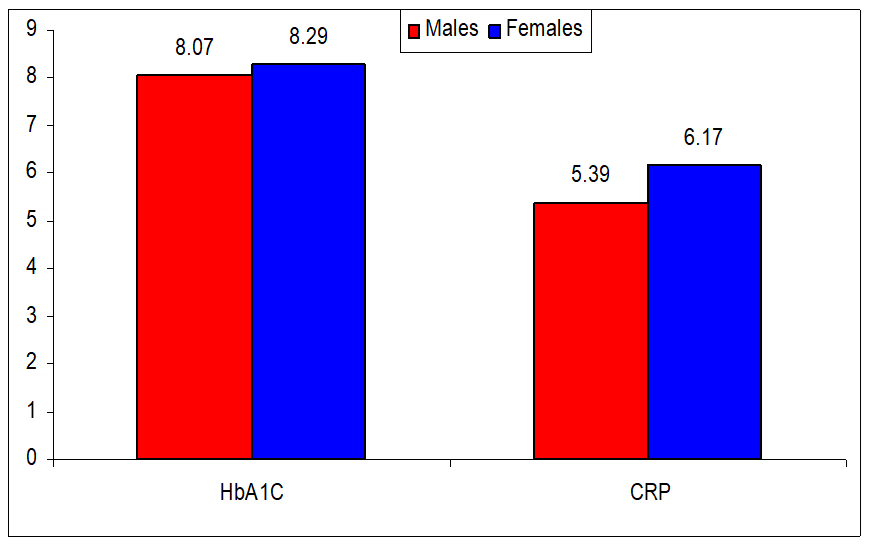
Figure 2: HbA1C and CRP level in diabetic males and females.
However, in this study of 70 patients, the diabetic patients were divided into three groups according to the different of HbA1C levels. Patients with HbA1C between of (5.0-7.0) were 34 patients, HbA1C between of (8.0-10) were 25 patients, while HbA1C of patients above 10 were 11 patients, and there mean CRP levels were 4.8±0.91, 4.4±0.66 and 9.31±2.94, respectively. The results showed that there was a significant correlation between CRP and HbA1C (Pless than0.05) among the three groups (Table 3 & Figure.3).
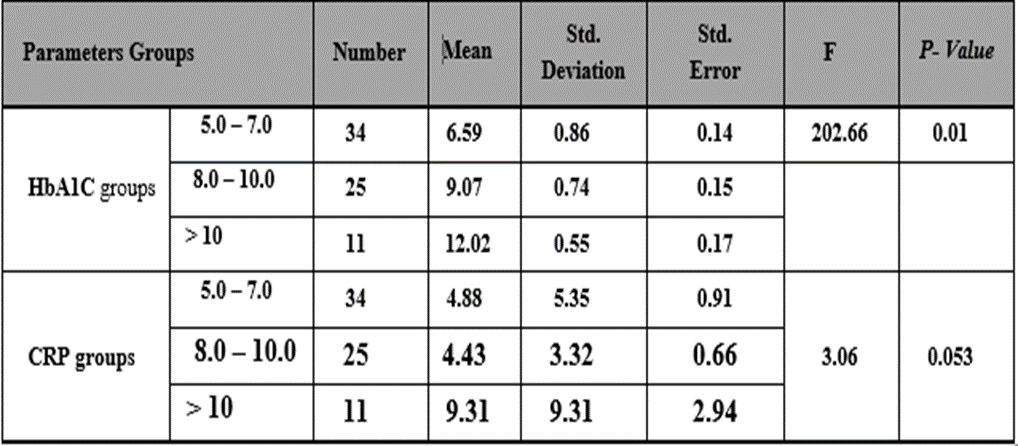
Table 3: The correlation between CRP and HbA1C in diabetic patients.
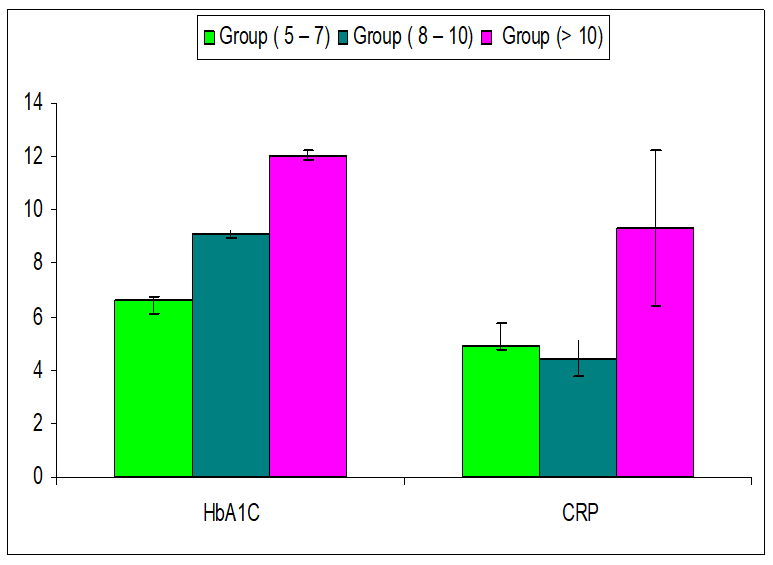
Figure 3: The correlation between CRP and HbA1C in diabetic patients.
As well as, in this study of 70 patients, HbA1C and CRP were correlated with age. So diabetic patents were divided into four groups according to the different of ages. The first group the age was between 30-39 years and the diabetic patents were 7 patients, with mean HbA1C and CRP of 8.23±1.97 and 6.29±2.11, respectively. Patients between ages 40-49 years were 16 with mean HbA1C and CRP of 8.08±1.99 and 4.89±1.46, respectively. Patients between ages 50-59 years were 16 with mean HbA1C and CRP of 8.51±2.14 and 4.88±0.69, respectively. While the patients above 60 years were 31 patients with mean HbA1C and CRP of 8.08±1.59 and 6.96±1.3, respectively. There was no significance between different age groups in this study ( pgreater than 0.05) (Table 4 & Figure.4).
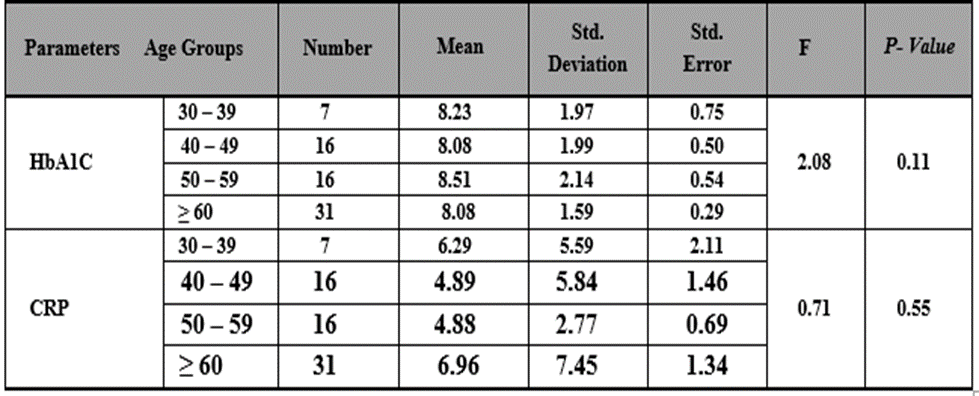
Table 4: The levels of HbA1C and CRP of diabetic patients correlated with different age groups.
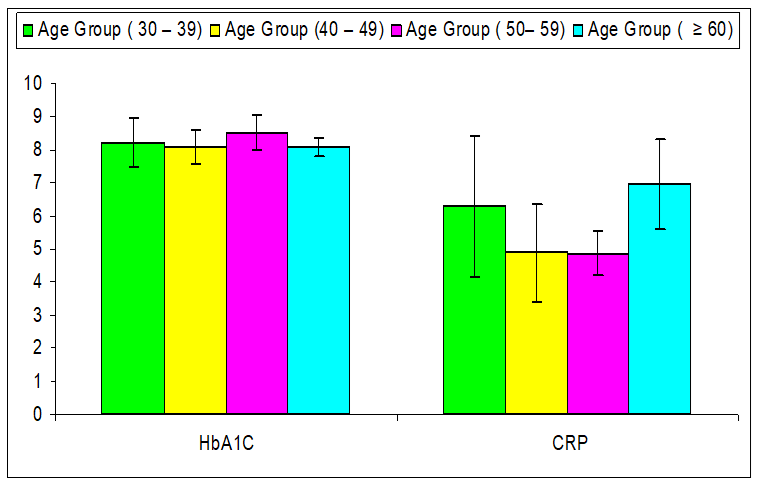
Figure 4: The levels of HbA1C and CRP of diabetic patients correlated with different age groups.

Table 5: The correlation between HbA1C and CRP in diabetic patients
Diabetes mellitus (DM) is a chronic metabolic disorder characterized by persistent hyperglycemia. It may be due to impaired insulin secretion or resistance to peripheral actions of insulin, or both. C-reactive protein (CRP). CRP is a pentameric protein synthesized by the liver, whose level rises in response to inflammation. Evidence of a relationship between HbA1c and inflammation was previously reported in studies that used CRP and WBC count to assess inflammation [ 18]. Analysis of data from NHANES III suggested that C-reactive protein (CRP), a principal downstream mediator of the acute phase inflammatory response, was significantly positively associated with HbA1c in a population of nondiabetic U.S. adults [17]. Therefore, this study has gone to the different factors that are related to both CRP and HbA1C of diabetic patients in zawia city. This study showed that a rise in HbA1C was significantly correlated with increasing values of CRP. It has showed that the concentration of CRP among diabetic group was higher (pless than 0.001) when compared with non – diabetic group. Thus, the CRP levels affected the HBA1C levels. Our results were in agreement with previous study by king and others [19] which demonstrated that a higher HBA1C is significantly associated with a higher CRP level. Currently, the hypothesis explaining the relationship between markers of inflammatory response and insulin resistance is that chronic inflammation can act as an inducer of insulin resistance or stimulate CRP synthesis by an underlying disease, eventually leading to typer 2 diabetes. However, in this study of 70 patient, 23 of them were male and 47 were female. The results in this research showed that no difference in (pgreater than 0.05) levels of CRP and HBA1C between male and female. This result was in contrary to previous study by Hu et al. [19] which demonstrated that the association between CRP and risk of diabetes was stronger in women than man. The different between our result and the result of Hu et al. [19] could be due to a smaller number of samples that collected in this study.
In this study of 70 diabetic patients, a positive correlation between CRP and HbA1C was found. The finding regarding gender and age in this study suggested that CRP and HbA1C were not significantly associated with gender and age.
Clearly Auctoresonline and particularly Psychology and Mental Health Care Journal is dedicated to improving health care services for individuals and populations. The editorial boards' ability to efficiently recognize and share the global importance of health literacy with a variety of stakeholders. Auctoresonline publishing platform can be used to facilitate of optimal client-based services and should be added to health care professionals' repertoire of evidence-based health care resources.

Journal of Clinical Cardiology and Cardiovascular Intervention The submission and review process was adequate. However I think that the publication total value should have been enlightened in early fases. Thank you for all.

Journal of Women Health Care and Issues By the present mail, I want to say thank to you and tour colleagues for facilitating my published article. Specially thank you for the peer review process, support from the editorial office. I appreciate positively the quality of your journal.
Journal of Clinical Research and Reports I would be very delighted to submit my testimonial regarding the reviewer board and the editorial office. The reviewer board were accurate and helpful regarding any modifications for my manuscript. And the editorial office were very helpful and supportive in contacting and monitoring with any update and offering help. It was my pleasure to contribute with your promising Journal and I am looking forward for more collaboration.

We would like to thank the Journal of Thoracic Disease and Cardiothoracic Surgery because of the services they provided us for our articles. The peer-review process was done in a very excellent time manner, and the opinions of the reviewers helped us to improve our manuscript further. The editorial office had an outstanding correspondence with us and guided us in many ways. During a hard time of the pandemic that is affecting every one of us tremendously, the editorial office helped us make everything easier for publishing scientific work. Hope for a more scientific relationship with your Journal.

The peer-review process which consisted high quality queries on the paper. I did answer six reviewers’ questions and comments before the paper was accepted. The support from the editorial office is excellent.

Journal of Neuroscience and Neurological Surgery. I had the experience of publishing a research article recently. The whole process was simple from submission to publication. The reviewers made specific and valuable recommendations and corrections that improved the quality of my publication. I strongly recommend this Journal.

Dr. Katarzyna Byczkowska My testimonial covering: "The peer review process is quick and effective. The support from the editorial office is very professional and friendly. Quality of the Clinical Cardiology and Cardiovascular Interventions is scientific and publishes ground-breaking research on cardiology that is useful for other professionals in the field.

Thank you most sincerely, with regard to the support you have given in relation to the reviewing process and the processing of my article entitled "Large Cell Neuroendocrine Carcinoma of The Prostate Gland: A Review and Update" for publication in your esteemed Journal, Journal of Cancer Research and Cellular Therapeutics". The editorial team has been very supportive.

Testimony of Journal of Clinical Otorhinolaryngology: work with your Reviews has been a educational and constructive experience. The editorial office were very helpful and supportive. It was a pleasure to contribute to your Journal.

Dr. Bernard Terkimbi Utoo, I am happy to publish my scientific work in Journal of Women Health Care and Issues (JWHCI). The manuscript submission was seamless and peer review process was top notch. I was amazed that 4 reviewers worked on the manuscript which made it a highly technical, standard and excellent quality paper. I appreciate the format and consideration for the APC as well as the speed of publication. It is my pleasure to continue with this scientific relationship with the esteem JWHCI.

This is an acknowledgment for peer reviewers, editorial board of Journal of Clinical Research and Reports. They show a lot of consideration for us as publishers for our research article “Evaluation of the different factors associated with side effects of COVID-19 vaccination on medical students, Mutah university, Al-Karak, Jordan”, in a very professional and easy way. This journal is one of outstanding medical journal.
Dear Hao Jiang, to Journal of Nutrition and Food Processing We greatly appreciate the efficient, professional and rapid processing of our paper by your team. If there is anything else we should do, please do not hesitate to let us know. On behalf of my co-authors, we would like to express our great appreciation to editor and reviewers.

As an author who has recently published in the journal "Brain and Neurological Disorders". I am delighted to provide a testimonial on the peer review process, editorial office support, and the overall quality of the journal. The peer review process at Brain and Neurological Disorders is rigorous and meticulous, ensuring that only high-quality, evidence-based research is published. The reviewers are experts in their fields, and their comments and suggestions were constructive and helped improve the quality of my manuscript. The review process was timely and efficient, with clear communication from the editorial office at each stage. The support from the editorial office was exceptional throughout the entire process. The editorial staff was responsive, professional, and always willing to help. They provided valuable guidance on formatting, structure, and ethical considerations, making the submission process seamless. Moreover, they kept me informed about the status of my manuscript and provided timely updates, which made the process less stressful. The journal Brain and Neurological Disorders is of the highest quality, with a strong focus on publishing cutting-edge research in the field of neurology. The articles published in this journal are well-researched, rigorously peer-reviewed, and written by experts in the field. The journal maintains high standards, ensuring that readers are provided with the most up-to-date and reliable information on brain and neurological disorders. In conclusion, I had a wonderful experience publishing in Brain and Neurological Disorders. The peer review process was thorough, the editorial office provided exceptional support, and the journal's quality is second to none. I would highly recommend this journal to any researcher working in the field of neurology and brain disorders.

Dear Agrippa Hilda, Journal of Neuroscience and Neurological Surgery, Editorial Coordinator, I trust this message finds you well. I want to extend my appreciation for considering my article for publication in your esteemed journal. I am pleased to provide a testimonial regarding the peer review process and the support received from your editorial office. The peer review process for my paper was carried out in a highly professional and thorough manner. The feedback and comments provided by the authors were constructive and very useful in improving the quality of the manuscript. This rigorous assessment process undoubtedly contributes to the high standards maintained by your journal.

International Journal of Clinical Case Reports and Reviews. I strongly recommend to consider submitting your work to this high-quality journal. The support and availability of the Editorial staff is outstanding and the review process was both efficient and rigorous.

Thank you very much for publishing my Research Article titled “Comparing Treatment Outcome Of Allergic Rhinitis Patients After Using Fluticasone Nasal Spray And Nasal Douching" in the Journal of Clinical Otorhinolaryngology. As Medical Professionals we are immensely benefited from study of various informative Articles and Papers published in this high quality Journal. I look forward to enriching my knowledge by regular study of the Journal and contribute my future work in the field of ENT through the Journal for use by the medical fraternity. The support from the Editorial office was excellent and very prompt. I also welcome the comments received from the readers of my Research Article.

Dear Erica Kelsey, Editorial Coordinator of Cancer Research and Cellular Therapeutics Our team is very satisfied with the processing of our paper by your journal. That was fast, efficient, rigorous, but without unnecessary complications. We appreciated the very short time between the submission of the paper and its publication on line on your site.

I am very glad to say that the peer review process is very successful and fast and support from the Editorial Office. Therefore, I would like to continue our scientific relationship for a long time. And I especially thank you for your kindly attention towards my article. Have a good day!

"We recently published an article entitled “Influence of beta-Cyclodextrins upon the Degradation of Carbofuran Derivatives under Alkaline Conditions" in the Journal of “Pesticides and Biofertilizers” to show that the cyclodextrins protect the carbamates increasing their half-life time in the presence of basic conditions This will be very helpful to understand carbofuran behaviour in the analytical, agro-environmental and food areas. We greatly appreciated the interaction with the editor and the editorial team; we were particularly well accompanied during the course of the revision process, since all various steps towards publication were short and without delay".

I would like to express my gratitude towards you process of article review and submission. I found this to be very fair and expedient. Your follow up has been excellent. I have many publications in national and international journal and your process has been one of the best so far. Keep up the great work.

We are grateful for this opportunity to provide a glowing recommendation to the Journal of Psychiatry and Psychotherapy. We found that the editorial team were very supportive, helpful, kept us abreast of timelines and over all very professional in nature. The peer review process was rigorous, efficient and constructive that really enhanced our article submission. The experience with this journal remains one of our best ever and we look forward to providing future submissions in the near future.

I am very pleased to serve as EBM of the journal, I hope many years of my experience in stem cells can help the journal from one way or another. As we know, stem cells hold great potential for regenerative medicine, which are mostly used to promote the repair response of diseased, dysfunctional or injured tissue using stem cells or their derivatives. I think Stem Cell Research and Therapeutics International is a great platform to publish and share the understanding towards the biology and translational or clinical application of stem cells.

I would like to give my testimony in the support I have got by the peer review process and to support the editorial office where they were of asset to support young author like me to be encouraged to publish their work in your respected journal and globalize and share knowledge across the globe. I really give my great gratitude to your journal and the peer review including the editorial office.

I am delighted to publish our manuscript entitled "A Perspective on Cocaine Induced Stroke - Its Mechanisms and Management" in the Journal of Neuroscience and Neurological Surgery. The peer review process, support from the editorial office, and quality of the journal are excellent. The manuscripts published are of high quality and of excellent scientific value. I recommend this journal very much to colleagues.

Dr.Tania Muñoz, My experience as researcher and author of a review article in The Journal Clinical Cardiology and Interventions has been very enriching and stimulating. The editorial team is excellent, performs its work with absolute responsibility and delivery. They are proactive, dynamic and receptive to all proposals. Supporting at all times the vast universe of authors who choose them as an option for publication. The team of review specialists, members of the editorial board, are brilliant professionals, with remarkable performance in medical research and scientific methodology. Together they form a frontline team that consolidates the JCCI as a magnificent option for the publication and review of high-level medical articles and broad collective interest. I am honored to be able to share my review article and open to receive all your comments.

“The peer review process of JPMHC is quick and effective. Authors are benefited by good and professional reviewers with huge experience in the field of psychology and mental health. The support from the editorial office is very professional. People to contact to are friendly and happy to help and assist any query authors might have. Quality of the Journal is scientific and publishes ground-breaking research on mental health that is useful for other professionals in the field”.

Dear editorial department: On behalf of our team, I hereby certify the reliability and superiority of the International Journal of Clinical Case Reports and Reviews in the peer review process, editorial support, and journal quality. Firstly, the peer review process of the International Journal of Clinical Case Reports and Reviews is rigorous, fair, transparent, fast, and of high quality. The editorial department invites experts from relevant fields as anonymous reviewers to review all submitted manuscripts. These experts have rich academic backgrounds and experience, and can accurately evaluate the academic quality, originality, and suitability of manuscripts. The editorial department is committed to ensuring the rigor of the peer review process, while also making every effort to ensure a fast review cycle to meet the needs of authors and the academic community. Secondly, the editorial team of the International Journal of Clinical Case Reports and Reviews is composed of a group of senior scholars and professionals with rich experience and professional knowledge in related fields. The editorial department is committed to assisting authors in improving their manuscripts, ensuring their academic accuracy, clarity, and completeness. Editors actively collaborate with authors, providing useful suggestions and feedback to promote the improvement and development of the manuscript. We believe that the support of the editorial department is one of the key factors in ensuring the quality of the journal. Finally, the International Journal of Clinical Case Reports and Reviews is renowned for its high- quality articles and strict academic standards. The editorial department is committed to publishing innovative and academically valuable research results to promote the development and progress of related fields. The International Journal of Clinical Case Reports and Reviews is reasonably priced and ensures excellent service and quality ratio, allowing authors to obtain high-level academic publishing opportunities in an affordable manner. I hereby solemnly declare that the International Journal of Clinical Case Reports and Reviews has a high level of credibility and superiority in terms of peer review process, editorial support, reasonable fees, and journal quality. Sincerely, Rui Tao.
